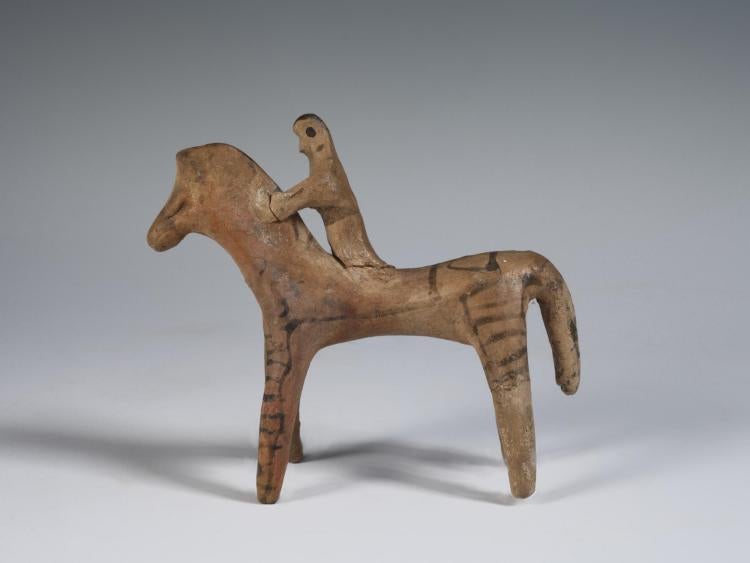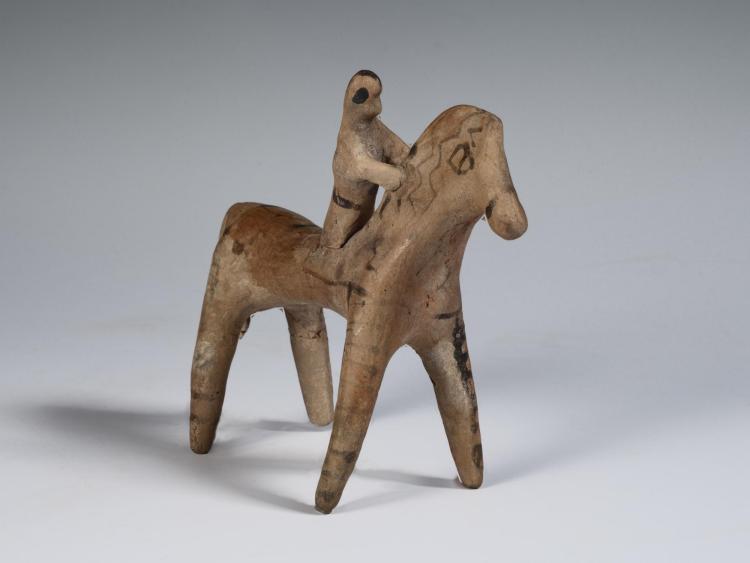2006.27.T, Horse and Rider Figurine
Catalogue Entry 

This vase is one of a collection of Greek artifacts held by the CU Art Museum.
Gift to CU Classics Department
Transferred to CU Museum of Natural History
Transferred to CU Art Museum (2006)
Height: 10.5 cm
Width: 12.1 cm
Depth: 4.8 cm
Date: c. 550 B.C.E.
Origin: Boeotia (central Greece)
Description: Small terracotta figurine of a horse with a legless rider on its back. Buff clay with details added in black.
Additional photos of this figurine show details of the decoration and various elements of the horse and rider.
Discussion

The simplicity of the figurine is its most notable feature. Despite the lack of details, however, the subject is immediately recognizable. The artist has managed to catch the spirit of the horse and rider through very basic shapes and patterns, rather than an accurate representation. The stripes on the horse's body, while clearly not anatomically accurate, add interest and even a sense of movement to the figure, which would otherwise be quite plain.
Horses were an important feature of ancient Greek life and are represented in figurines, sculpture, and other forms of art, including vase painting. Horse-and-rider figurines, like this one, were popular in 6th century B.C.E. Boeotia (2). Terracotta figurines, which were probably quite inexpensive, may have been used as toys for children, as offerings to the dead, or as votive dedications at religious sanctuaries (3). Popular, too, were figurines depicting other animals, real or imagined, as well as human figures and goddesses, all of which themes are represented in the CU Art Museum's collection. An early 6th century B.C.E. figurine of a harpy displays an interest in representing human-animal hybrids. A 6th century B.C.E. East Greek figurine may represent the goddess Aphrodite. Two others, a mid-6th century B.C.E. Boeotian figurine and a contemporary example from Laconia, represent female figures, but it is unclear if they are human or divine.
Comparanda
- Frederick R. Grace, Archaic Sculpture in Boeotia (Rome: L'Erma di Bretschneider, 1969): Figs. 47, 49, and 51.
- Reynold Alleyne Higgins, Catalogue of Terracottas in the British Museum (London: British Museum, 1954): No. 770.
Footnotes
- Chara Tzavella-Evjen, Greek and Roman Vases and Statuettes from the University of Colorado Collection (Athens: Archaiologikon Deltion, 1973): 192-197.
- Reynold Alleyne Higgins, Greek Terracottas (London: Methuen & Co, 1967): 46, pl. 19E.
- Caroline Amy Hutton, Greek Terracotta Statuettes (London: Seeley and Co. Ltd., 1899): 1-13; Higgins, Greek Terracottas: xlix-l.
Reference
- Chara Tzavella-Evjen, Greek and Roman Vases and Statuettes from the University of Colorado Collection (Athens: Archaiologikon Deltion, 1973): 192-197.

